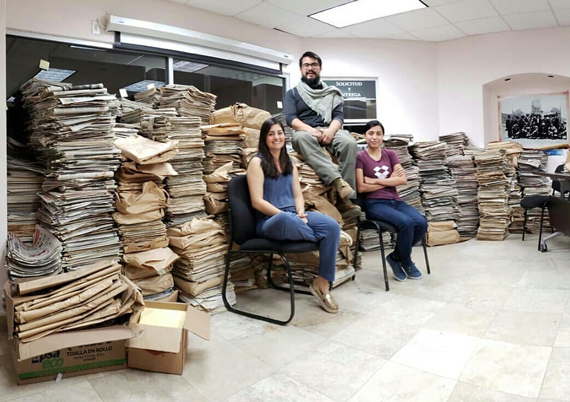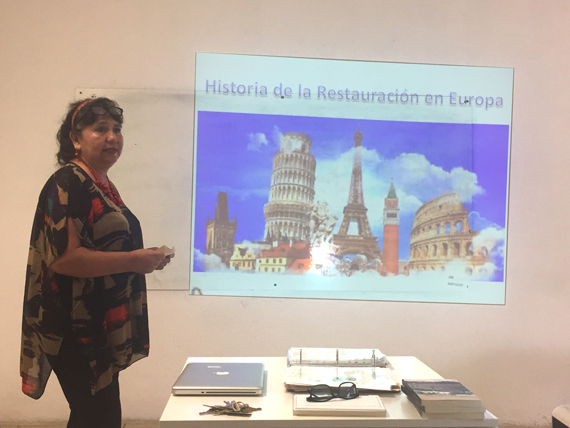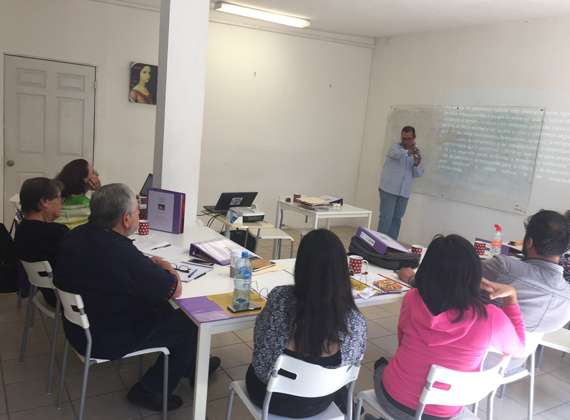|
Historic Preservation Course Launches in Tijuana
By Maria Curry
November/December 2018
 Viridiana Ambriz and Luisa Trampe, students in the new preservation course, at work as historians at the Tijuana historic archive, with the archive director, Dr. Emmanuel Robles. |
 Our Heritage columnist and preservation historian Maria Curry lecturing on preservation in Europe. |
 Dr. Josue Beltran discusses the definition of cultural patrimony. All photos by Gabriel Rivera Delgado |
With great satisfaction, I wish to announce that a groundbreaking new historic preservation course on Mexico-U.S. border cities began in September at the graduate center Sor Juana in Tijuana (Centro de Posgrado y Estudios Sor Juana). I am proud to be the coordinator of this class and one of its instructors.
The objective is to train students to become advocates and experts in a field that has been neglected in Baja California, resulting in the destruction of important landmarks. Several students are also focused on preserving and protecting the region's indigenous heritage and cultures.
The ten students who enrolled in Diplomado en Preservación del Patrimonio Cultural en Ciudades Fronterizas come from Tijuana, Tecate, and Mexicali. All have interesting backgrounds and experience that enrich the class discussions.
One of the students from Mexicali has published books about the history of the state capital, another is a cultural promoter with several preservation projects in Mexicali. A student from Tecate serves on the Baja California Council of Cultural Patrimony (the state-level equivalent of the City of San Diego's Historical Resources Board).
From Tijuana, we have a famous historian who ran the city's historic archive for 15 years and has published over 1,000 articles and several books, two students who work in the archive, and the director of the History of Tijuana museum. Two retired teachers enrolled to learn preservation theory and practice to apply to the restoration of Agua Caliente casino in Tijuana. Finally, we have a student who owns a real estate company that sells old buildings in downtown Tijuana and is interested in restoring some of them.
The knowledgeable lecturers are also talented and come from various academic institutions, preservation organizations, and the private sector. They live in California, Tijuana, and Mexico City, with three representing SOHO: Amie K. Hayes, historic resources specialist; Vonn Marie May, cultural landscape specialist/historian; and myself. I also represent ICOMOS Mexicano (the International Council of Monuments and Sites) and we will be joined by Ernesto Becerril Miró, vice president of ICOMOS International.
Chicano Park Steering Committee members Victor Ochoa and Josephine Talamantez will discuss San Diego's nationally renowned historic site and outdoor mural collection.
Other lecturers come from the Universidad de las Californias, Universidad de Durango, Universidad Autónoma de Baja California, Universidad de Tijuana, and El Colegio de la Frontera Norte. The rest are private consultants from Mexico City and California.
The curricula includes the theory and history of preservation in Europe, the U.S., Mexico, and Baja California; preservation law; architectural styles and preservation specifications; documentation methodologies suitable to Mexican border cities that share a common history with the American Southwest; case studies of grassroots preservation efforts; and the study and preservation of historic landscapes.
We are planning several site visits, including to downtown Tijuana, where many historic building are threatened; la Libertad neighborhood; and what remains of the Agua Caliente casino.
Enthusiastic students are already using their new knowledge and skills to support their projects. They are also dedicated. I am especially impressed with two women who come from Mexicali and are always on time after traveling three hours to attend the class.
The students are brainstorming to solve some urgent or current issues in Baja California. How can we legally change the name of a street to its original name? How can we create a report for the designation of what remains of Agua Caliente as part of the state cultural patrimony? How do we gather information for an article about the history of preservation in Baja California, or survey and create an inventory of cultural patrimony?
The students are also interested in learning how to negotiate and reconcile the interests of developers, the community, and the government to protect abandoned and neglected historic buildings and cultural sites. Using the tools they've acquired in this course, some students recently met with government officials, politicians, and businessmen interested in investing in preservation. Their goal is to foster economically feasible restoration and adaptive reuse projects that will create economic development.
We are seeking volunteer help from architects or 20th-century architecture experts who can help us with restoration proposals. We are hopeful that we will find this support, as always, benefitting the preservation of our shared regional history.
The course runs through March 2019, with classes held twice a month. For more information, visit HERE. Google will translate the course description into English, if you wish.
|
2025
2024
2023
2022
2021
2020
2019
2018
2017
2016
2015
|






